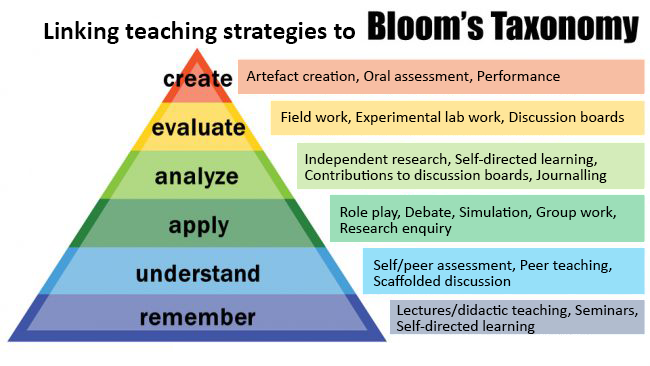Teaching Strategies

Coherence between learning outcomes, assessment activity, and teaching and learning approaches is essential for effective programme and module design. Keeping your learning outcomes in mind will help you select appropriate assessments and teaching strategies.
In this page we list some of the factors that need to be considered when selecting teaching strategies, and how the learning outcomes can be used in this process.
Selecting Teaching Strategies – what needs to be considered
- Which teaching strategies will guide and facilitate learners towards the achievement of learning outcomes?
- Do those teaching strategies align with the mode of delivery selected for the programme/module?
- Are there discipline specific pedagogies that need to be considered?
- Are the teaching strategies consistent across the programme/module?
- How do you envisage the architecture of the individual modules? E.g. long and thin / short and fat?
- Are the technologies required by the teaching strategies available and familiar?
Select the teaching and learning strategies that align with your intended learning outcomes and support students in completing the assessments.
The image below can be used to help select teaching strategies that are known to support students in achieving the learning outcomes associated with the six levels of learning outlined by Bloom.

The sections below contain more detailed information on mapping the learning outcomes to teaching strategies. Examples of strategies that worked also presented.
Examples of teaching strategies that worked within TCD
In November 2021 four academics from within the college presented teaching strategies worked in their discipline during Covid.
- Being a part of Our Place in a disrupted World-Peter Bryant
- Reframing archaeological practice modules-Christine Morris
- Responses in Physics to Covid 19-Cormac Mc Guinness
- Person, Participant, Player-The Trinity of roles in a practical drama workshop or class
- Adapting the in-person clinical environment to the online environment-David McReynolds
Further Examples of teaching strategies that worked in other Universities
Dr. Peter Bryant discusses how the business school in the University of Sydney have changed their teaching and learning strategies in his presentation ‘Being a part of Our Place in a disrupted world’.
Click on the links below to open the sections.
Further detailed mapping of verbs to teaching strategies
The table below outlines a range of teaching and learning approaches commonly aligned to particular learning outcomes using Bloom’s revised Taxonomy as a framework (particularly his work in the cognitive domain of learning – see Anderson and Krathwohl, 2001. Keep in mind that baseline expectations of knowledge acquisition and retention often underpin learning outcomes framing complex knowledge, skills, and behaviours.
Learning outcome |
Related verbs |
Teaching strategies |
|---|---|---|
| Knowledge acquisition and retention | Recognise, Recall, State, Outline, Identify, Describe, Match, Order, Name, Label, Reproduce. |
|
| Understanding and comprehension | Interpret, Exemplify, Clarify, Classify, Paraphrase, Summarise, Infer, Compare, Explain, Represent, Translate, Illustrate, Categorise. |
|
| Application of knowledge in a given situation. | Apply, Implement, Demonstrate, Illustrate, Interpret, Execute. |
|
| Analysis, classification, structural understanding, hypothesis testing, and evidencing. | Analyse, Differentiate, Organise, Attribute, Appraise, Critique, Compare. |
|
| Evaluating, evidencing and defending judgment or analysis. | Evaluate, Critique, Appraise, Argue, Justify, Explain, Predict, Support, Defend. |
|
| Creating, integrating, or synthesising ideas, concepts or practices coherently. | Create, Generate, Plan, Produce, Design, Modify, Develop, Invent, Write. |
|
These strategies may be used as part of problem-based learning, inquiry-based learning, case-based learning and other teaching and learning pedagogies. Strategies suggested here are neither exhaustive nor prescriptive.
Discipline Specific Pedagogies
Discipline specific pedagogies, often referred to as signature pedagogies, are forms of teaching approaches that are common to specific disciplines. Follow this link for more on Signature Pedagogies
Key Takeaways
- Select teaching strategies that support students in achieving the learning outcomes
- Using Blooms taxonomy will help you select the appropriate teaching strategies
- Use teaching strategies that facilitate students learning in order to successfully complete the assessments
- Make sure the teaching strategies align with the modes of delivery selected for the programme/module
- Ensure consistency of teaching strategy across the programme/module.

